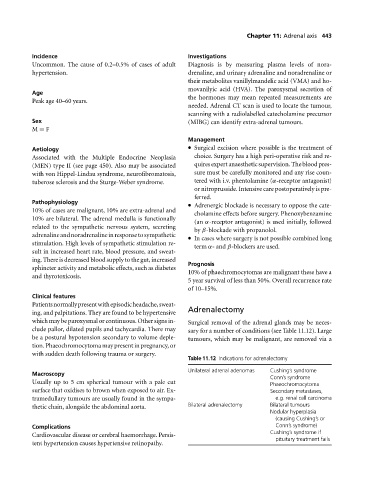Page 447 - Medicine and Surgery
P. 447
P1: FAW
BLUK007-11 BLUK007-Kendall May 25, 2005 8:5 Char Count= 0
Chapter 11: Adrenal axis 443
Incidence Investigations
Uncommon. The cause of 0.2–0.5% of cases of adult Diagnosis is by measuring plasma levels of nora-
hypertension. drenaline, and urinary adrenaline and noradrenaline or
their metabolites vanillylmandelic acid (VMA) and ho-
movanilyic acid (HVA). The paroxysmal secretion of
Age
the hormones may mean repeated measurements are
Peak age 40–60 years.
needed. Adrenal CT scan is used to locate the tumour,
scanning with a radiolabelled catecholamine precursor
Sex (MIBG) can identify extra-adrenal tumours.
M = F
Management
Aetiology Surgical excision where possible is the treatment of
Associated with the Multiple Endocrine Neoplasia choice. Surgery has a high peri-operative risk and re-
(MEN) type II (see page 450). Also may be associated quires expert anaesthetic supervision. The blood pres-
with von Hippel-Lindau syndrome, neurofibromatosis, sure must be carefully monitored and any rise coun-
tuberose sclerosis and the Sturge-Weber syndrome. teredwith i.v. phentolamine (α-receptor antagonist)
or nitroprusside. Intensive care postoperatively is pre-
ferred.
Pathophysiology
Adrenergic blockade is necessary to oppose the cate-
10% of cases are malignant, 10% are extra-adrenal and
cholamine effects before surgery. Phenoxybenzamine
10% are bilateral. The adrenal medulla is functionally
(an α-receptor antagonist) is used initially, followed
related to the sympathetic nervous system, secreting
by β-blockade with propanolol.
adrenalineandnoradrenalineinresponsetosympathetic
In cases where surgery is not possible combined long
stimulation. High levels of sympathetic stimulation re-
term α- and β-blockers are used.
sult in increased heart rate, blood pressure, and sweat-
ing. There is decreased blood supply to the gut, increased
Prognosis
sphincter activity and metabolic effects, such as diabetes
10% of phaechromocytomas are malignant these have a
and thyrotoxicosis.
5year survival of less than 50%. Overall recurrence rate
of 10–15%.
Clinical features
Patientsnormallypresentwithepisodicheadache,sweat-
ing, and palpitations. They are found to be hypertensive Adrenalectomy
which may be paroxysmal or continuous. Other signs in- Surgical removal of the adrenal glands may be neces-
clude pallor, dilated pupils and tachycardia. There may sary for a number of conditions (see Table 11.12). Large
be a postural hypotension secondary to volume deple- tumours, which may be malignant, are removed via a
tion. Phaeochromocytoma may present in pregnancy, or
with sudden death following trauma or surgery.
Table 11.12 Indications for adrenalectomy
Unilateral adrenal adenomas Cushing’s syndrome
Macroscopy
Conn’s syndrome
Usually up to 5 cm spherical tumour with a pale cut Phaeochromocytoma
surface that oxidises to brown when exposed to air. Ex- Secondary metastases,
tramedullary tumours are usually found in the sympa- e.g. renal cell carcinoma
thetic chain, alongside the abdominal aorta. Bilateral adrenalectomy Bilateral tumours
Nodular hyperplasia
(causing Cushing’s or
Complications Conn’s syndrome)
Cushing’s syndrome if
Cardiovascular disease or cerebral haemorrhage. Persis-
pituitary treatment fails
tent hypertension causes hypertensive retinopathy.

